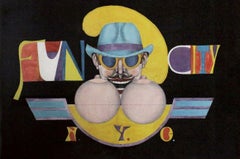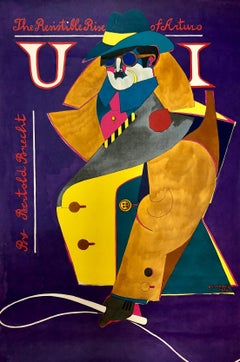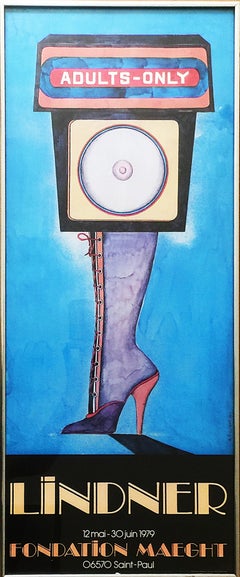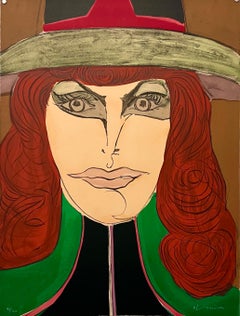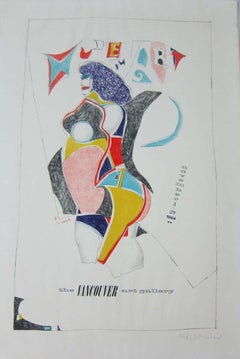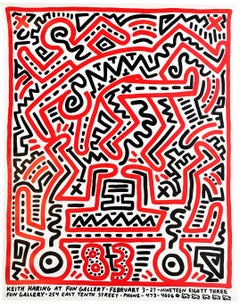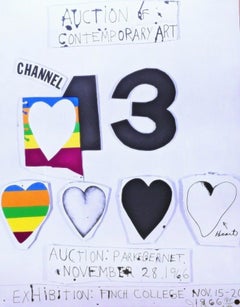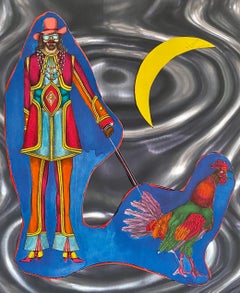Richard Lindner Abstract Prints
American, 1901-1978
Richard Lindner (1901 – 1978) was a German-American painter. Lindner's mother was owner of a custom-fitting corset business and Richard Lindner grew up and studied at the Kunstgewerbeschule (Arts and Crafts School since 1940 Academy of Fine Arts). From 1924 to 1927 he lived in Munich and studied there from 1925 at the Kunstakademie. In 1927 Lindner moved to Berlin and stayed there until 1928, when he returned to Munich to become art director of a publishing firm. He remained in Munich until 1933, when he was forced to flee to Paris. Once in Paris, Lindner became politically engaged, sought contact with French artists and earned his living as a commercial artist. He was interned when World War II broke out in 1939 and later served in the French Army. In 1941, Lindner moved to the United States and worked in New York City as an illustrator of books and magazines. There he made contact with New York artists and German emigrants such as Albert Einstein, Marlene Dietrich, and Saul Steinberg. In 1948, Lindner became an American citizen. Lindner taught at a number of institutions including the Pratt Institute, Brooklyn, Hochschule fur bildende Kunste in Hamburg and Yale University School of Art and Architecture. His paintings often used the sexual symbolism of advertising and investigated definitions of gender roles in the media.(Biography provided by ArtWise)
to
6
1
1
5
2
4
2
1
Overall Height
to
Overall Width
to
6
1
1
1
1
1
1
7
3
3
36
543
428
200
179
7
2
Artist: Richard Lindner
Vintage Modern Lithograph Poster 1960s Pop Art Mod Figure
By Richard Lindner
Located in Surfside, FL
Vintage 1960's Lithograph poster for Vancouver Canada art show.
Richard Lindner was born in Hamburg, Germany. In 1905 the family moved to Nuremberg, where Lindners mother was owner o...
Category
1960s Pop Art Richard Lindner Abstract Prints
Materials
Lithograph
Fun City, N.Y.C.
By Richard Lindner
Located in New York, NY
A very good impression of this color lithograph. Signed and numbered 125/175 in pencil, lower margin.
Category
1970s Pop Art Richard Lindner Abstract Prints
Materials
Color, Lithograph
Offset Lithograph Poster Resistible Rise of Arturo, Bertold Brecht 1968 Pop Art
By Richard Lindner
Located in Surfside, FL
Plate signed and dated, offset lithograph.
Richard Lindner was born in Hamburg, Germany. In 1905 the family moved to Nuremberg, where Lindners mother was owner of a custom-fitting co...
Category
1960s Pop Art Richard Lindner Abstract Prints
Materials
Lithograph, Offset
Adults-Only
By Richard Lindner
Located in New York, NY
Richard Lindner
Adults-Only, 1979
Offset lithograph poster
Plate signature with date, right front
Frame Included: held in vintage 1970s metal period frame
This is a rare vintage post...
Category
1970s Pop Art Richard Lindner Abstract Prints
Materials
Lithograph, Offset
1971 Modernist Lithograph Redhead Pop Art Mod Fashionable Woman Richard Lindner
By Richard Lindner
Located in Surfside, FL
RICHARD LINDNER (American. 1901-1978)
Hand Signed limited edition lithograph with blindstamp
Publisher: Shorewood-Bank Street Atelier for the Skowhegan School of Painting and Sculpture
29.25 X 22 inches
Richard Lindner was born in Hamburg, Germany. In 1905 the family moved to Nuremberg, where Lindner's mother was owner of a custom-fitting corset business and Richard Lindner grew up and studied at the Kunstgewerbeschule (Arts and Crafts School since 1940 Academy of Fine Arts). From 1924 to 1927 he lived in Munich and studied there from 1925 at the Kunstakademie. In 1927 he moved to Berlin and stayed there until 1928, when he returned to Munich to become art director of a publishing firm. He remained there until 1933, when he was forced to flee to Paris, where he became politically engaged, sought contact with French artists and earned his living as a commercial artist. He was interned when the war broke out in 1939 and later served in the French Army. In 1941 he went to the United States and worked in New York City as an illustrator of books and magazines (Vogue, Fortune and Harper's Bazaar). He began painting seriously in 1952, holding his first one-man exhibit in 1954. His style blends a mechanistic cubism with personal images and haunting symbolism. LIndner maintained contact with the emigre community including New York artists and German emigrants (Albert Einstein, Marlene Dietrich, Saul Steinberg). Though he became a United States citizen in 1948, Lindner considered himself a New Yorker, but not a true American. However, over the course of time, his continental circus women became New York City streetwalkers. New York police uniforms replaced European military uniforms as symbols of authority.At a time when Abstract Expressionism was all the rage, Lindner’s painting went against the current and always kept its distance. His pictorial language of vibrant colours and broad planes of colour and his urban themes make him a forerunner of American Pop Art. At the same time, he owes the critical tone of his paintings to the influence of European art movements such as Neue Sachlichkeit and Dada. His first exhibition did not take place until 1954, by which time he was over fifty, and, interestingly, it was held at the Betty Parsons Gallery in New York, a venue associated with the American Expressionists. From 1952 he taught at the Pratt Institute, Brooklyn, from 1967 at Yale University School of Art and Architecture, New Haven. In 1957 Lindner got the William and Norma Copley Foundation-Award. In 1965 he became Guest Professor at the Akademie für Bildende Künste, Hamburg. His Ice (1966, Whitney Museum of American Art) established a connection between the metaphysical tradition and pop art. He did work on Rowlux which was used by a number of pop artists (most notably Roy Lichtenstein)The painting shows harsh, flat geometric shapes framing an erotic but mechanical robot-woman. His paintings used the sexual symbolism of advertising and investigated definitions of gender roles in the media. While influencing Pop Art (Andy Warhol, Tom Wesselmann and Claes Oldenburg amongst others) his highly colourful, hard-edge style seems to have brought him close to Pop Art, which he rejected. Nevertheless, he is immortalised on the cover of the Beatles record "Sgt. Pepper’s Lonely Hearts Club Band" (1967) as a patron of the pop culture. He also did a tapestry banner with the Betsy Ross Flag...
Category
1970s Pop Art Richard Lindner Abstract Prints
Materials
Lithograph
Vintage Modern Lithograph Poster 1960s Pop Art Mod Figure Pencil Signed
By Richard Lindner
Located in Surfside, FL
Richard Lindner was born in Hamburg, Germany. In 1905 the family moved to Nuremberg, where Lindners mother was owner of a custom-fitting corset business and Richard Lindner grew up and studied at the Kunstgewerbeschule (Arts and Crafts School since 1940 Academy of Fine Arts). From 1924 to 1927 he lived in Munich and studied there from 1925 at the Kunstakademie. In 1927 he moved to Berlin and stayed there until 1928, when he returned to Munich to become art director of a publishing firm. He remained there until 1933, when he was forced to flee to Paris, where he became politically engaged, sought contact with French artists and earned his living as a commercial artist. He was interned when the war broke out in 1939 and later served in the French Army. In 1941 he went to the United States and worked in New York City as an illustrator of books and magazines (Vogue, Fortune and Harper's Bazaar). He began painting seriously in 1952, holding his first one-man exhibit in 1954. His style blends a mechanistic cubism with personal images and haunting symbolism. LIndner maintained contact with the emigre community including New York artists and German emigrants (Albert Einstein, Marlene Dietrich, Saul Steinberg). Though he became a United States citizen in 1948, Lindner considered himself a New Yorker, but not a true American. However, over the course of time, his continental circus women became New York City streetwalkers. New York police uniforms replaced European military uniforms as symbols of authority.At a time when Abstract Expressionism was all the rage, Lindner’s painting went against the current and always kept its distance. His pictorial language of vibrant colours and broad planes of colour and his urban themes make him a forerunner of American Pop Art. At the same time, he owes the critical tone of his paintings to the influence of European art movements such as Neue Sachlichkeit and Dada. His first exhibition did not take place until 1954, by which time he was over fifty, and, interestingly, it was held at the Betty Parsons Gallery in New York, a venue associated with the American Expressionists. From 1952 he taught at the Pratt Institute, Brooklyn, from 1967 at Yale University School of Art and Architecture, New Haven. In 1957 Lindner got the William and Norma Copley Foundation-Award. In 1965 he became Guest Professor at the Akademie für Bildende Künste, Hamburg. His Ice (1966, Whitney Museum of American Art) established a connection between the metaphysical tradition and pop art. The painting shows harsh, flat geometric shapes framing an erotic but mechanical robot-woman.His paintings used the sexual symbolism of advertising and investigated definitions of gender roles in the media. While influencing Pop Art (Tom Wesselman and Claes Oldenburg amongst others) his highly colourful, hard-edge style seems to have brought him close to Pop Art, which he rejected. Nevertheless, he is immortalised on the cover of the Beatles record...
Category
1960s Pop Art Richard Lindner Abstract Prints
Materials
Lithograph
1970's New York original lithograph by Richard Lindner
By Richard Lindner
Located in Petworth, West Sussex
A funky urban image from 1971 depicting some of the nuances of New York seedy underbelly. This original lithograph is number 73 of and edition of 75 from the 1971 'Fun City' suite. Originally there were 12 different artworks in this series by Richard Lindner of which this is the title piece.
Signed in pencil 'R Lindner...
Category
Late 20th Century Modern Richard Lindner Abstract Prints
Materials
Lithograph
Related Items
Keith Haring Fun Gallery exhibition poster 1983 (vintage Keith Haring)
By Keith Haring
Located in NEW YORK, NY
Keith Haring Fun Gallery 1983:
Original 1983 Keith Haring illustrated exhibition poster published on the occasion of Haring's historic 1983 show at the Fun Gallery in the East Village. A classic array of early Haring imagery that reveals red and black interlocking figures. A rare example in very good overall vintage condition.
Offset lithograph in colors on smooth wove paper.
23 x 29 inches.
Only some minor signs of handling; in otherwise very good overall vintage condition with strong colors; one of the better examples we've come across. Stored away from light; never mounted or framed.
Unsigned from an edition of unknown; scarce.
Catalog Raisonne:
Keith Haring: Posters (Prestel Publishing).
References:
Included in the collection of the Cooper Hewitt, Smithsonian Design Museum.
About the Fun Gallery:
Historic, short-lived, East Village gallery known for giving Keith Haring, Basquiat & Kenny Scharf some of their first solo shows.
“FUN Gallery was a place where neighborhood kids, downtown artists, b-boys, rock, film, and rap stars mixed with museum directors art historians and uptown collectors at wild openings featuring artists like Futura, Fab 5...
Category
1980s Pop Art Richard Lindner Abstract Prints
Materials
Lithograph, Offset
Five Hearts for Channel 13 (Public Television), deluxe hand signed limited ed.
By Jim Dine
Located in New York, NY
Jim Dine
Love for Channel 13
Lithograph. Hand signed and numbered recto
27 × 21 1/2 inches
Edition 185/200
Signed and numbered 185/200 in graphite pencil on the recto
Unframed
Rarel...
Category
1960s Pop Art Richard Lindner Abstract Prints
Materials
Lithograph, Offset, Pencil
Expressive Painting After Picasso catalog 1983 (Basquiat cover)
By after Jean-Michel Basquiat
Located in NEW YORK, NY
Basquiat Cover Art 1983:
Rare early 1980s exhibition catalogue published on the occasion of: “Expressive Painting After Picasso”- a group featuring works by: Pablo Picasso, Jean-Michel Basquiat, Francis Bacon, Georg Baselitz, Joan Miro & more at the Beyeler Gallery, Basel Switzerland.
Medium: Exhibition catalog 1983; softcover, 48 pages.
Dimensions: 10 x 11.5 Inches
Very good overall vintage condition.
Unsigned from an edition of unknown.
Jean-Michel Basquiat’s dramatic life and iconic paintings—which variously feature obsessive scribbling, enigmatic symbols and diagrams, and iconography including skulls, masks, and the artist’s trademark crown—make him one of the most famous artists of the 20th century. The self-taught painter embraced graffiti before committing to a studio practice. He found a mentor and friend in Andy Warhol, who helped the young artist navigate the 1980s New York art world. Across his oeuvre, Basquiat drew on his own Caribbean heritage; a convergence of African American, African, and Aztec cultural histories; classical themes; and pop cultural figures including athletes and musicians. The immediacy and intellectual depth of his paintings won him widespread acclaim both before and after his untimely death at the age of 27. Basquiat’s paintings now belong in the collections of the Museum of Modern Art, the Museum of Contemporary Art, Los Angeles, the Whitney Museum of American Art, and the Metropolitan Museum of Art, among others. In 2017, Basquiat’s Untitled (1982) notched $110.5 million at auction and became the most expensive artwork by an American artist to ever be sold.
Related Categories:
Basquiat ephemera. Basquiat Picasso. Vintage Basquiat. Basquiat 1983.
Category
1980s Pop Art Richard Lindner Abstract Prints
Materials
Paper, Lithograph, Offset
"Go for Baroque" lithograph poster, hand signed & inscribed by Roy Lichtenstein
By Roy Lichtenstein
Located in New York, NY
Roy Lichtenstein
"Go for Baroque" poster (hand signed and inscribed by Roy Lichtenstein), 1994
Color offset lithograph on wove paper (hand signed and inscribed to Lichtenstein's esta...
Category
1990s Pop Art Richard Lindner Abstract Prints
Materials
Lithograph, Offset, Ink
Basquiat Paris 1998 (vintage Basquiat announcement)
By after Jean-Michel Basquiat
Located in NEW YORK, NY
Basquiat Paris 1998:
Rare vintage original announcement card to the exhibit, Jean-Michel Basquiat Temoignage 1977-1988, Galerie Jerome De Noirmont, Paris, 1998:
6 x 9 inches (folde...
Category
1980s Pop Art Richard Lindner Abstract Prints
Materials
Offset, Lithograph
Basquiat Enrico Navarra Gallery Paris 1999 (announcement)
By after Jean-Michel Basquiat
Located in NEW YORK, NY
Jean-Michel Basquiat Enrico Navarra Gallery Paris 1999:
Rare vintage Basquiat Mr Chow announcement card published on the occasion of: Jean-Michel Basquiat, Gal...
Category
1980s Pop Art Richard Lindner Abstract Prints
Materials
Paper, Offset
The Red Horsemen (Equestrians) signed offset lithograph poster with Olympic COA
By Roy Lichtenstein
Located in New York, NY
Roy Lichtenstein
The Red Horsemen, aka The Equestrians (with COA from the 1984 Olympic Committee), 1982
Limited Edition Offset Lithograph on Parsons Diploma Parchment Paper.
Pencil...
Category
1980s Pop Art Richard Lindner Abstract Prints
Materials
Offset, Pencil, Lithograph
Flag I /// Pop Art Jasper Johns Abstract Lithograph Black Modern American ULAE
By (After) Jasper Johns
Located in Saint Augustine, FL
Artist: (after) Jasper Johns (American, 1930-)
Title: "Flag I"
Series: Facsimile Catalogue of Jasper Johns Prints
*Issued unsigned
Year: 1975
Mediu...
Category
1970s Pop Art Richard Lindner Abstract Prints
Materials
Lithograph, Offset
Art About Art, iconic Whitney Museum of American Pop Art lithographic poster
By Roy Lichtenstein
Located in New York, NY
Roy Lichtenstein
Art About Art Whitney Museum of American Art 1978 poster, 1978
Offset lithograph poster
Frame included: held in the original vintage frame
Provenance:
from the collection of Jack Martin...
Category
1970s Pop Art Richard Lindner Abstract Prints
Materials
Lithograph, Offset
H 36.5 in W 25.25 in D 1 in
1-2-3 Outside James Rosenquist pop art muscle car print blue and orange
By James Rosenquist
Located in New York, NY
1-2-3 Outside reproduces James Rosenquist’s 1963 oil painting of the same name, collected in the Spencer Museum of Art, The University of Kansas, Lawrence. Rosenquist sourced the ima...
Category
1970s Pop Art Richard Lindner Abstract Prints
Materials
Lithograph
Untitled Zwirner Gallery exhibition poster
By Yayoi Kusama
Located in New York, NY
Yayoi Kusama
Offset lithograph poster, 2017
Published by David Zwirner
Unframed, with original folds as issued (see photo)
Gorgeous Yayoi Kusama offset lithograph poster published by David Zwirner Gallery for a 2018 exhibition. It has natural folds as it was folded in a square, but is otherwise in excellent condition and the folds will frame out
This print originally accompanied the monograph "Yayoi Kusama: Festival of Life," published to accompany an exhibition held at David Zwirner, New York, 2017.
It was printed in a limited, but unknown edition and has since sold out
Yayoi Kusama Biography
Yayoi Kusama's work has transcended two of the most important art movements of the second half of the twentieth century: Pop art and Minimalism. Her highly influential career spans paintings, performances, room-size presentations, outdoor sculptural installations, literary works, films, fashion, design, and interventions within existing architectural structures, which allude at once to microscopic and macroscopic universes.
Born in 1929 in Matsumoto, Japan, Kusama’s work has been featured widely in both solo and group presentations. She presented her first solo show in her native Japan in 1952. In the mid-1960s, she established herself in New York as an important avant-garde artist by staging groundbreaking and influential happenings, events, and exhibitions. Her work gained renewed widespread recognition in the late 1980s following a number of international solo exhibitions, including shows at the Center for International Contemporary Arts, New York, and the Museum of Modern Art, Oxford, both of which took place in 1989. She represented Japan in 1993 at the 45th Venice Biennale, to much critical acclaim. In 1998, the Los Angeles County Museum of Art and the Museum of Modern Art, New York, co-organized Love Forever: Yayoi Kusama, 1958–1968, which toured to the Walker Art Center, Minneapolis (1998-1999), and Museum of Contemporary Art, Tokyo (1999).
More recently, in 2011 to 2012, her work was the subject of a large-scale retrospective that traveled to the Museo Nacional Centro de Arte Reina Sofía, Madrid; Centre Georges Pompidou, Paris; Tate Modern, London; and the Whitney Museum of American Art, New York. From 2012 through 2015, three major museum solo presentations of the artist’s work simultaneously traveled to major museums throughout Japan, Asia, and Central and South America. In 2015, the Louisiana Museum of Modern Art in Humlebæk, Denmark, organized a comprehensive overview of Kusama’s practice that traveled to Henie-Onstad Kunstsenter, Høvikodden, Norway; Moderna Museet, Stockholm; and Helsinki Art Museum. In 2017-2019, a major survey of the artist’s work, Infinity Mirrors, was presented at the Hirshhorn Museum and Sculpture Garden, Washington, DC; Seattle Art Museum; The Broad, Los Angeles; Art Gallery of Ontario, Toronto; The Cleveland Museum of Art, Ohio; and the High Museum of Art, Atlanta, Georgia. Yayoi Kusama: Life Is the Heart of the Rainbow, which marked the first large-scale exhibition of Kusama’s work presented in Southeast Asia, opened at the National Gallery of Singapore in 2017 and traveled to the Queensland Art Gallery Gallery of Modern Art in Brisbane, Australia and the Museum of Modern and Contemporary Art in Nusantara, Jakarta. In 2019, All About Love Speaks Forever, an exhibition "tailor-made" specifically for the Fosun Foundation, Shanghai included more than 40 works by the artist.
A comprehensive retrospective of the artist’s work was on view at Gropius Bau, Berlin in 2021, and traveled to the Tel Aviv Museum of Art in 2022. KUSAMA: Cosmic Nature...
Category
2010s Pop Art Richard Lindner Abstract Prints
Materials
Lithograph, Offset
Sunrise
By Roy Lichtenstein
Located in New York, NY
A very good impression of this early color offset lithograph. Signed in pencil by Lichtenstein. Printed by Colorcraft, New York. Published by Leo Castelli Gallery, New York.
Catalo...
Category
1960s Pop Art Richard Lindner Abstract Prints
Materials
Color, Lithograph, Offset
Previously Available Items
Modernist Lithograph Lovers Kiss Pop Art Mod Figure Richard Lindner Graphic Art
By Richard Lindner
Located in Surfside, FL
RICHARD LINDNER (American. 1901-1978)
32/49 Hand Signed ithograph
Framed MEASURES 43" X 57" IMAGE MEASURES 26" X 20"
Richard Lindner was born in Hamburg, Germany. In 1905 the family moved to Nuremberg, where Lindners mother was owner of a custom-fitting corset business and Richard Lindner grew up and studied at the Kunstgewerbeschule (Arts and Crafts School since 1940 Academy of Fine Arts). From 1924 to 1927 he lived in Munich and studied there from 1925 at the Kunstakademie. In 1927 he moved to Berlin and stayed there until 1928, when he returned to Munich to become art director of a publishing firm. He remained there until 1933, when he was forced to flee to Paris, where he became politically engaged, sought contact with French artists and earned his living as a commercial artist. He was interned when the war broke out in 1939 and later served in the French Army. In 1941 he went to the United States and worked in New York City as an illustrator of books and magazines (Vogue, Fortune and Harper's Bazaar). He began painting seriously in 1952, holding his first one-man exhibit in 1954. His style blends a mechanistic cubism with personal images and haunting symbolism. LIndner maintained contact with the emigre community including New York artists and German emigrants (Albert Einstein, Marlene Dietrich, Saul Steinberg). Though he became a United States citizen in 1948, Lindner considered himself a New Yorker, but not a true American. However, over the course of time, his continental circus women became New York City streetwalkers. New York police uniforms replaced European military uniforms as symbols of authority.At a time when Abstract Expressionism was all the rage, Lindner’s painting went against the current and always kept its distance. His pictorial language of vibrant colours and broad planes of colour and his urban themes make him a forerunner of American Pop Art. At the same time, he owes the critical tone of his paintings to the influence of European art movements such as Neue Sachlichkeit and Dada. His first exhibition did not take place until 1954, by which time he was over fifty, and, interestingly, it was held at the Betty Parsons Gallery in New York, a venue associated with the American Expressionists. From 1952 he taught at the Pratt Institute, Brooklyn, from 1967 at Yale University School of Art and Architecture, New Haven. In 1957 Lindner got the William and Norma Copley Foundation-Award. In 1965 he became Guest Professor at the Akademie für Bildende Künste, Hamburg. His Ice (1966, Whitney Museum of American Art) established a connection between the metaphysical tradition and pop art. He did work on Rowlux which was used by a number of pop artists (most notably Roy Lichtenstein)The painting shows harsh, flat geometric shapes framing an erotic but mechanical robot-woman. His paintings used the sexual symbolism of advertising and investigated definitions of gender roles in the media. While influencing Pop Art (Andy Warhol, Tom Wesselmann and Claes Oldenburg amongst others) his highly colourful, hard-edge style seems to have brought him close to Pop Art, which he rejected. Nevertheless, he is immortalised on the cover of the Beatles record "Sgt. Pepper’s Lonely Hearts Club Band" (1967) as a patron of the pop culture. He also did a tapestry banner with the Betsy Ross Flag...
Category
1970s Pop Art Richard Lindner Abstract Prints
Materials
Lithograph
Modernist Lithograph and Collage on Rowlux Pop Art Mod Figure Richard Lindner
By Richard Lindner
Located in Surfside, FL
St. Marks, 1971
Lithograph and Collage on Gray Rowlux
Rowlux was used by a number of pop artists (most notably Roy Lichtenstein)
Richard Lindner was born in Hamburg, Germany. In 1905 the family moved to Nuremberg, where Lindners mother was owner of a custom-fitting corset business and Richard Lindner grew up and studied at the Kunstgewerbeschule (Arts and Crafts School since 1940 Academy of Fine Arts). From 1924 to 1927 he lived in Munich and studied there from 1925 at the Kunstakademie. In 1927 he moved to Berlin and stayed there until 1928, when he returned to Munich to become art director of a publishing firm. He remained there until 1933, when he was forced to flee to Paris, where he became politically engaged, sought contact with French artists and earned his living as a commercial artist. He was interned when the war broke out in 1939 and later served in the French Army. In 1941 he went to the United States and worked in New York City as an illustrator of books and magazines (Vogue, Fortune and Harper's Bazaar). He began painting seriously in 1952, holding his first one-man exhibit in 1954. His style blends a mechanistic cubism with personal images and haunting symbolism. LIndner maintained contact with the emigre community including New York artists and German emigrants (Albert Einstein, Marlene Dietrich, Saul Steinberg). Though he became a United States citizen in 1948, Lindner considered himself a New Yorker, but not a true American. However, over the course of time, his continental circus women became New York City streetwalkers. New York police uniforms replaced European military uniforms as symbols of authority.At a time when Abstract Expressionism was all the rage, Lindner’s painting went against the current and always kept its distance. His pictorial language of vibrant colours and broad planes of colour and his urban themes make him a forerunner of American Pop Art. At the same time, he owes the critical tone of his paintings to the influence of European art movements such as Neue Sachlichkeit and Dada. His first exhibition did not take place until 1954, by which time he was over fifty, and, interestingly, it was held at the Betty Parsons Gallery in New York, a venue associated with the American Expressionists. From 1952 he taught at the Pratt Institute, Brooklyn, from 1967 at Yale University School of Art and Architecture, New Haven. In 1957 Lindner got the William and Norma Copley Foundation-Award. In 1965 he became Guest Professor at the Akademie für Bildende Künste, Hamburg. His Ice (1966, Whitney Museum of American Art) established a connection between the metaphysical tradition and pop art. The painting shows harsh, flat geometric shapes framing an erotic but mechanical robot-woman. His paintings used the sexual symbolism of advertising and investigated definitions of gender roles in the media. While influencing Pop Art (Tom Wesselmann and Claes Oldenburg amongst others) his highly colourful, hard-edge style seems to have brought him close to Pop Art, which he rejected. Nevertheless, he is immortalised on the cover of the Beatles record...
Category
1970s Pop Art Richard Lindner Abstract Prints
Materials
Plastic, Lithograph
Vintage Modern Lithograph Poster 1960s Pop Art Mod Figure
By Richard Lindner
Located in Surfside, FL
Vintage 1960's Lithograph poster for Vancouver Canada art show.
Richard Lindner was born in Hamburg, Germany. In 1905 the family moved to Nuremberg, where Lindners mother was owner of a custom-fitting corset business and Richard Lindner grew up and studied at the Kunstgewerbeschule (Arts and Crafts School since 1940 Academy of Fine Arts). From 1924 to 1927 he lived in Munich and studied there from 1925 at the Kunstakademie. In 1927 he moved to Berlin and stayed there until 1928, when he returned to Munich to become art director of a publishing firm. He remained there until 1933, when he was forced to flee to Paris, where he became politically engaged, sought contact with French artists and earned his living as a commercial artist. He was interned when the war broke out in 1939 and later served in the French Army. In 1941 he went to the United States and worked in New York City as an illustrator of books and magazines (Vogue, Fortune and Harper's Bazaar). He began painting seriously in 1952, holding his first one-man exhibit in 1954. His style blends a mechanistic cubism with personal images and haunting symbolism. LIndner maintained contact with the emigre community including New York artists and German emigrants (Albert Einstein, Marlene Dietrich, Saul Steinberg). Though he became a United States citizen in 1948, Lindner considered himself a New Yorker, but not a true American. However, over the course of time, his continental circus women became New York City streetwalkers. New York police uniforms replaced European military uniforms as symbols of authority.At a time when Abstract Expressionism was all the rage, Lindner’s painting went against the current and always kept its distance. His pictorial language of vibrant colours and broad planes of colour and his urban themes make him a forerunner of American Pop Art. At the same time, he owes the critical tone of his paintings to the influence of European art movements such as Neue Sachlichkeit and Dada. His first exhibition did not take place until 1954, by which time he was over fifty, and, interestingly, it was held at the Betty Parsons Gallery in New York, a venue associated with the American Expressionists. From 1952 he taught at the Pratt Institute, Brooklyn, from 1967 at Yale University School of Art and Architecture, New Haven. In 1957 Lindner got the William and Norma Copley Foundation-Award. In 1965 he became Guest Professor at the Akademie für Bildende Künste, Hamburg. His Ice (1966, Whitney Museum of American Art) established a connection between the metaphysical tradition and pop art. The painting shows harsh, flat geometric shapes framing an erotic but mechanical robot-woman.His paintings used the sexual symbolism of advertising and investigated definitions of gender roles in the media. While influencing Pop Art (Tom Wesselman and Claes Oldenburg amongst others) his highly colourful, hard-edge style seems to have brought him close to Pop Art, which he rejected. Nevertheless, he is immortalised on the cover of the Beatles record...
Category
1960s Pop Art Richard Lindner Abstract Prints
Materials
Lithograph
Offset Lithograph Poster Resistible Rise of Arturo, Bertold Brecht 1968 Pop Art
By Richard Lindner
Located in Surfside, FL
Plate signed and dated, offset lithograph.
Richard Lindner was born in Hamburg, Germany. In 1905 the family moved to Nuremberg, where Lindners mother was owner of a custom-fitting corset business and Richard Lindner grew up and studied at the Kunstgewerbeschule (Arts and Crafts School since 1940 Academy of Fine Arts). From 1924 to 1927 he lived in Munich and studied there from 1925 at the Kunstakademie. In 1927 he moved to Berlin and stayed there until 1928, when he returned to Munich to become art director of a publishing firm. He remained there until 1933, when he was forced to flee to Paris, where he became politically engaged, sought contact with French artists and earned his living as a commercial artist. He was interned when the war broke out in 1939 and later served in the French Army. In 1941 he went to the United States and worked in New York City as an illustrator of books and magazines (Vogue, Fortune and Harper's Bazaar). He began painting seriously in 1952, holding his first one-man exhibit in 1954. His style blends a mechanistic cubism with personal images and haunting symbolism. LIndner maintained contact with the emigre community including New York artists and German emigrants (Albert Einstein, Marlene Dietrich, Saul Steinberg). Though he became a United States citizen in 1948, Lindner considered himself a New Yorker, but not a true American. However, over the course of time, his continental circus women became New York City streetwalkers. New York police uniforms replaced European military uniforms as symbols of authority.At a time when Abstract Expressionism was all the rage, Lindner’s painting went against the current and always kept its distance. His pictorial language of vibrant colours and broad planes of colour and his urban themes make him a forerunner of American Pop Art. At the same time, he owes the critical tone of his paintings to the influence of European art movements such as Neue Sachlichkeit and Dada. His first exhibition did not take place until 1954, by which time he was over fifty, and, interestingly, it was held at the Betty Parsons Gallery in New York, a venue associated with the American Expressionists. From 1952 he taught at the Pratt Institute, Brooklyn, from 1967 at Yale University School of Art and Architecture, New Haven. In 1957 Lindner got the William and Norma Copley Foundation-Award. In 1965 he became Guest Professor at the Akademie für Bildende Künste, Hamburg. His Ice (1966, Whitney Museum of American Art) established a connection between the metaphysical tradition and pop art. The painting shows harsh, flat geometric shapes framing an erotic but mechanical robot-woman.His paintings used the sexual symbolism of advertising and investigated definitions of gender roles in the media. While influencing Pop Art (Tom Wesselman and Claes Oldenburg amongst others) his highly colourful, hard-edge style seems to have brought him close to Pop Art, which he rejected. Nevertheless, he is immortalised on the cover of the Beatles record...
Category
1960s Pop Art Richard Lindner Abstract Prints
Materials
Offset, Lithograph
Vintage Modern Lithograph Poster 1960s Pop Art Mod Figure Pencil Signed
By Richard Lindner
Located in Surfside, FL
Richard Lindner was born in Hamburg, Germany. In 1905 the family moved to Nuremberg, where Lindners mother was owner of a custom-fitting corset business and Richard Lindner grew up and studied at the Kunstgewerbeschule (Arts and Crafts School since 1940 Academy of Fine Arts). From 1924 to 1927 he lived in Munich and studied there from 1925 at the Kunstakademie. In 1927 he moved to Berlin and stayed there until 1928, when he returned to Munich to become art director of a publishing firm. He remained there until 1933, when he was forced to flee to Paris, where he became politically engaged, sought contact with French artists and earned his living as a commercial artist. He was interned when the war broke out in 1939 and later served in the French Army. In 1941 he went to the United States and worked in New York City as an illustrator of books and magazines (Vogue, Fortune and Harper's Bazaar). He began painting seriously in 1952, holding his first one-man exhibit in 1954. His style blends a mechanistic cubism with personal images and haunting symbolism. LIndner maintained contact with the emigre community including New York artists and German emigrants (Albert Einstein, Marlene Dietrich, Saul Steinberg). Though he became a United States citizen in 1948, Lindner considered himself a New Yorker, but not a true American. However, over the course of time, his continental circus women became New York City streetwalkers. New York police uniforms replaced European military uniforms as symbols of authority.At a time when Abstract Expressionism was all the rage, Lindner’s painting went against the current and always kept its distance. His pictorial language of vibrant colours and broad planes of colour and his urban themes make him a forerunner of American Pop Art. At the same time, he owes the critical tone of his paintings to the influence of European art movements such as Neue Sachlichkeit and Dada. His first exhibition did not take place until 1954, by which time he was over fifty, and, interestingly, it was held at the Betty Parsons Gallery in New York, a venue associated with the American Expressionists. From 1952 he taught at the Pratt Institute, Brooklyn, from 1967 at Yale University School of Art and Architecture, New Haven. In 1957 Lindner got the William and Norma Copley Foundation-Award. In 1965 he became Guest Professor at the Akademie für Bildende Künste, Hamburg. His Ice (1966, Whitney Museum of American Art) established a connection between the metaphysical tradition and pop art. The painting shows harsh, flat geometric shapes framing an erotic but mechanical robot-woman.His paintings used the sexual symbolism of advertising and investigated definitions of gender roles in the media. While influencing Pop Art (Tom Wesselman and Claes Oldenburg amongst others) his highly colourful, hard-edge style seems to have brought him close to Pop Art, which he rejected. Nevertheless, he is immortalised on the cover of the Beatles record...
Category
1960s Pop Art Richard Lindner Abstract Prints
Materials
Lithograph
Richard Lindner abstract prints for sale on 1stDibs.
Find a wide variety of authentic Richard Lindner abstract prints available for sale on 1stDibs. You can also browse by medium to find art by Richard Lindner in lithograph, offset print and more. Much of the original work by this artist or collective was created during the 20th century and is mostly associated with the Pop Art style. Not every interior allows for large Richard Lindner abstract prints, so small editions measuring 17 inches across are available. Customers who are interested in this artist might also find the work of CLAYTON POND, Jack Brusca, and Red Grooms. Richard Lindner abstract prints prices can differ depending upon medium, time period and other attributes. On 1stDibs, the price for these items starts at $500 and tops out at $2,420, while the average work can sell for $1,200.

